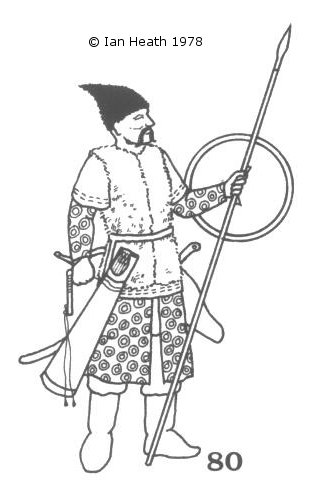Cuman Cavalryman
An extract from Armies and Enemies of the Crusades 1096-1291by Ian Heath

|
80. CUMAN CAVALRYMAN At various times during this period the Cumans (also called Kipchaks, or Polovtsy by the Russians) fought either as allies or mercenaries for the Byzantines, Georgians, Mongols and Romanian Franks as well as the Russians, Bulgarians and Hungarians, and as slave-soldiers in Ayyubid, Mamluk and Khwarizmian armies. They may also, towards the end of the 11th century, have served with the Khazars during the twilight years of the Khaganate. They wore trousers, boots, long Arab-style tunic and kaftan. Brocade, fur, wool and linen predominated, but goatskins were also worn and Robert de Clan, recording the events of the Fourth Crusade, speaks of the Cumans wearing a sheepskin garment which may have been intended to serve as light armour. Other forms of armour including scale and lamellar were also worn depending on wealth and social status; for such richer warrior types see figures 115-117 in 'Armies of Feudal Europe'. Robert de Clan implies that the Cumans were armed only with their bows, but Byzantine and Russian sources also record sabres, lances, lassoes, maces and javelins in use, the Cumans being noted for their accuracy with the latter. Most shields were small circular ones, but some Cumans carried a small version of the kite shield. They also included some foot-soldiers on occasion. These probably rode camels on the march. The Cumans' Russian name 'Polovtsy' and German name 'Falven' both originated from words meaning yellow, which is fairly certainly a reference to skin colour. Revised as "Cumans were handsome, blue eyed and blonde-haired*; despite what I have written elsewhere, it was doubtless their hair rather than their skin colour that gave rise to the Russian and German names Polovtsy and Falven given to the Cumans, these originating from words meaning 'yellow'." in Cuman, 12th-13th centuries in Armies of Feudal Europe 1066-1300 by Ian Heath |
Next: 81. ALAN CAVALRYMAN in Armies and Enemies of the Crusades 1096-1291 by Ian Heath
Back to the contents for Extracts from Armies and Enemies of the Crusades 1096-1291 by Ian Heath
